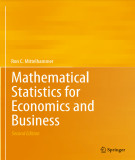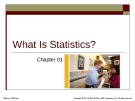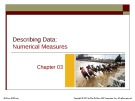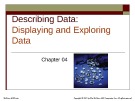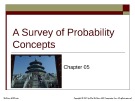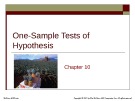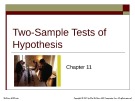
Basic statistics for business
-
Part 1 of ebook "Statistics for business" provides readers with contents including: presenting and organizing data; characterizing and defining data; basic probability and counting rules; probability analysis for discrete data; probability analysis in the normal distribution; theory and methods of statistical sampling; estimating population characteristics;...
 275p
275p  thamnhuocgiai
thamnhuocgiai
 24-09-2023
24-09-2023
 5
5
 4
4
 Download
Download
-
Part 1 of ebook "Applied statistics for business and management using Microsoft Excel" has presents the following content: Chapter 1 - Data and statistics; Chapter 2 - Introduction to excel and basic charts; Chapter 3 - Summarizing data - descriptive statistics and histograms; Chapter 4 - Normal distributions; Chapter 5 - Survey design; Chapter 6 - Sampling; Chapter 7 - Inference; Chapter 8 - Probability;...
 216p
216p  dieptieuung
dieptieuung
 20-07-2023
20-07-2023
 3
3
 2
2
 Download
Download
-
Part 1 of ebook "Mathematical statistics for economics and business" provide readers with content about: elements of probability theory; random variables, densities, and cumulative distribution functions; expectations and moments of random variables; parametric families of density functions; basic asymptotics; sampling, sample moments and sampling distributions;...
 388p
388p  damtuyetha
damtuyetha
 16-02-2023
16-02-2023
 4
4
 2
2
 Download
Download
-
Lecture Business statistics - Chapter 4: Introduction to probability. The main topics covered in this chapter include: statistics in practice; experiments, event and their probabilities; some basic relationships of probability;... Please refer to the lecture for details!
 12p
12p  chutieubang
chutieubang
 06-12-2022
06-12-2022
 9
9
 2
2
 Download
Download
-
The research used data from the General Statistics Office of Viet Nam for 6 years (2012-2017) to analyze the operation efficiency of Vietnam’s paper enterprises. From the statistical results, Vietnam’s paper industry is attracting many investors which registered a huge number of new enterprises over the years. This paper shows that the basic characteristic of Viet Nam's paper enterprises is to focus on industrial zones, mostly small scales and privately owned. The average annual income of workers in this field is about 78.5 million VND per person per year.
 16p
16p  huyetthienthan
huyetthienthan
 23-11-2021
23-11-2021
 12
12
 0
0
 Download
Download
-
(bq) part 2 book "basic business statistics - concepts and applications" has contents: analysis of variance, simple linear regression, introduction to multiple regression, multiple regression model building, statistical applications in quality management, a road map for analyzing data,...and other contents.
 446p
446p  bautroibinhyen23
bautroibinhyen23
 02-04-2017
02-04-2017
 62
62
 7
7
 Download
Download
-
(bq) part 1 book "basic statistics for business & economics" has contents: what is statistics, describing data - frequency distributions and graphic presentation; describing data - numerical measures; a survey of probability concepts; discrete probability distributions; continuous probability distributions; sampling methods and the central limit theorem.
 261p
261p  bautroibinhyen23
bautroibinhyen23
 02-04-2017
02-04-2017
 87
87
 8
8
 Download
Download
-
(bq) part 2 book "basic statistics for business & economics" has contents: estimation and confidence intervals; one sample tests of hypothesis; two sample tests of hypothesis; analysis of variance; linear regression and correlation; multiple regression and correlation analysis; chi square applications
 320p
320p  bautroibinhyen23
bautroibinhyen23
 02-04-2017
02-04-2017
 43
43
 7
7
 Download
Download
-
the sixth edition provides a thorough grounding in basic mathematical and statisical techniques for business students, and students on a professional course such as accounting. the result is a comprehensive, user-friendly, testing oriented guide to quantitative methods for business.
 332p
332p  bautroibinhyen20
bautroibinhyen20
 06-03-2017
06-03-2017
 82
82
 8
8
 Download
Download
-
Chapter 2 - Describing data: Frequency tables, frequency distributions, and graphic presentation. After completing this unit, you should be able to: Organize qualitative data into a frequency table, present a frequency table as a bar chart or a pie chart, organize quantitative data into a frequency distribution, present a frequency distribution for quantitative data using histograms, frequency polygons, and cumulative frequency polygons.
 15p
15p  whocare_e
whocare_e
 04-10-2016
04-10-2016
 35
35
 2
2
 Download
Download
-
Chapter 1: What is statistics? When you have completed this chapter, you will be able to: List ways that statistics is used, know the differences between descriptive and inferential statistics, understand the differences between a sample and a population, explain the difference between qualitative and quantitative variables, compare the discrete and continuous variables, recognize the levels of measurement in data.
 14p
14p  whocare_e
whocare_e
 04-10-2016
04-10-2016
 48
48
 1
1
 Download
Download
-
Chapter 3 - Describing data: Numerical measures. Learning objectives of this chapter include: Calculate the arithmetic mean, weighted mean, median, mode, and geometric mean; explain the characteristics, uses, advantages, and disadvantages of each measure of location; identify the position of the mean, median, and mode for both symmetric and skewed distributions; compute and interpret the range, mean deviation, variance, and standard deviation
 15p
15p  whocare_e
whocare_e
 04-10-2016
04-10-2016
 47
47
 1
1
 Download
Download
-
Chapter 4 - Describing data: Displaying and exploring data. After studying this chapter you will be able to: Construct and interpret a dot plot, identify and compute measures of position, construct and analyze a box plot, compute and describe the coefficient of skewness, create and interpret a scatter diagram, develop and explain a contingency table.
 15p
15p  whocare_e
whocare_e
 04-10-2016
04-10-2016
 71
71
 1
1
 Download
Download
-
Chapter 5 - A survey of probability concepts. After studying this chapter you will be able to: Explain the terms experiment, event, and outcome; identify and apply the appropriate approach to assigning probabilities; calculate probabilities using the rules of addition; define the term joint probability; calculate probabilities using the rules of multiplication;...
 15p
15p  whocare_e
whocare_e
 04-10-2016
04-10-2016
 37
37
 1
1
 Download
Download
-
Chapter 6 - Discrete probability distributions. After completing this unit, you should be able to: Identify the characteristics of a probability distribution, distinguish between a discrete and a continuous random variable, compute the mean of a probability distribution, compute the variance and standard deviation of a probability distribution,...
 15p
15p  whocare_e
whocare_e
 04-10-2016
04-10-2016
 42
42
 1
1
 Download
Download
-
Chapter 7: Continuous probability distributions. When you have completed this chapter you will be able to: List the characteristics of the uniform distribution; compute probabilities by using the uniform distribution; list the characteristics of the normal probability distribution; convert a normal distribution to the standard normal distribution;...
 15p
15p  whocare_e
whocare_e
 04-10-2016
04-10-2016
 42
42
 1
1
 Download
Download
-
Chapter 9 - Estimation and confidence intervals. In this chapter, students will be able to understand: Define a point estimate, define confidence interval, compute a confidence interval for the population mean when the population standard deviation is known, compute a confidence interval for a population mean when the population standard deviation is unknown,...
 15p
15p  whocare_e
whocare_e
 04-10-2016
04-10-2016
 42
42
 2
2
 Download
Download
-
Chapter 10 - One-sample tests of hypothesis. In this chapter you will be able to: Define a hypothesis, explain the five-step hypothesis-testing procedure, define type i and type ii errors, define the term test statistic and explain how it is used, distinguish between a one-tailed and a two-tailed hypothesis,...
 15p
15p  whocare_e
whocare_e
 04-10-2016
04-10-2016
 58
58
 2
2
 Download
Download
-
Chapter 8 - Sampling methods and the central limit theorem. After completing this unit, you should be able to: Explain why a sample is often the only feasible way to learn something about a population, describe methods to select a sample, define sampling error, describe the sampling distribution of the sample mean,...
 15p
15p  whocare_e
whocare_e
 04-10-2016
04-10-2016
 43
43
 1
1
 Download
Download
-
Chapter 11 - Two-sample tests of hypothesis. Learning objectives of this chapter include: Test a hypothesis that two independent population means with known population standard deviations are equal; carry out a hypothesis test that two population proportions are equal; conduct a hypothesis test that two independent population means are equal, assuming equal but unknown population standard deviations;...
 15p
15p  whocare_e
whocare_e
 04-10-2016
04-10-2016
 36
36
 1
1
 Download
Download
CHỦ ĐỀ BẠN MUỐN TÌM










